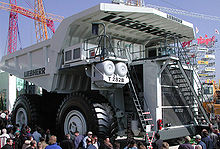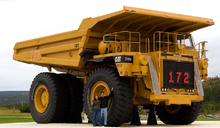
A truck or lorry is a motor vehicle designed to transport freight, carry specialized payloads, or perform other utilitarian work. Trucks vary greatly in size, power, and configuration, but the vast majority feature body-on-frame construction, with a cabin that is independent of the payload portion of the vehicle. Smaller varieties may be mechanically similar to some automobiles. Commercial trucks can be very large and powerful and may be configured to be mounted with specialized equipment, such as in the case of refuse trucks, fire trucks, concrete mixers, and suction excavators. In American English, a commercial vehicle without a trailer or other articulation is formally a "straight truck" while one designed specifically to pull a trailer is not a truck but a "tractor".

A loader is a heavy equipment machine used in construction to move or load materials such as soil, rock, sand, demolition debris, etc. into or onto another type of machinery.

A dump truck, known also as a dumping truck, dump trailer, dumper trailer, dump lorry or dumper lorry or a dumper for short, is used for transporting materials for construction as well as coal. A typical dump truck is equipped with an open-box bed, which is hinged at the rear and equipped with hydraulic rams to lift the front, allowing the material in the bed to be deposited ("dumped") on the ground behind the truck at the site of delivery. In the UK, Australia, South Africa and India the term applies to off-road construction plants only and the road vehicle is known as a tip lorry, tipper lorry, tipper truck, tip truck, tip trailer or tipper trailer or simply a tipper.

The Liebherr T 282 series are off-highway, ultra class, rigid frame, two axle, diesel-electric, AC powertrain haul trucks designed and manufactured in the United States by Liebherr Mining Equipment Co.

A dumper or dumper truck or dump truck is a truck designed for carrying bulk material, often on building sites. A dumper has a body which tilts or opens at the back for unloading and is usually an open 4-wheeled vehicle with the load skip in front of the driver. The skip can tip to dump the load; this is where the name "dumper" comes from. They are normally diesel powered. A towing eye is fitted for secondary use as a site tractor. Dumpers with rubber tracks are used in special circumstances and provide a more even distribution of weight compared to tires. Continuous tracks allow the operator to carry heavier payload on slick, snowy, or muddy surfaces, and are popular in some countries. Rubber track dumpers offer even weight distribution for transporting heavy payloads over challenging terrains like mud or snow, popular in certain regions. Roll Off Dumpsters, contrastingly, are large, stationary containers designed for substantial waste management, easily loaded and transported by specialized trucks.

The Studebaker US6 (G630) was a series of 2+1⁄2-ton 6×6 and 5-ton 6×4 trucks manufactured by the Studebaker Corporation and REO Motor Car Company during World War II. The basic cargo version was designed to transport a 2+1⁄2-short-ton cargo load over any type of terrain in any weather. Most of these were exported to the Soviet Union under Lend-Lease by the USA during World War II, since the competing GMC 6×6 CCKW design proved to be more suitable for Western Front conditions.

The Caterpillar 740 Ejector Articulated Truck is Caterpillar's second generation of articulated haulers to have a system that pushes material out the back of the body. It is the largest articulated haul truck offered by Caterpillar; larger trucks use a rigid frame system. The ejector uses a 4-cylinder hydraulic ram and blade to dump the material out, a similar system to Cat's wheel tractor-scrapers. The 740 Ejector is sold as separate model from the usual 740.

The Caterpillar 797 is a series of off-highway, ultra class, two-axle, mechanical powertrain haul trucks developed and manufactured in the United States by Caterpillar Inc. specifically for high-production mining and heavy construction applications worldwide. In production since 1998, the 797 series represents Caterpillar’s largest, highest capacity haul trucks. The current, third-generation model, the 797F, offers one of the largest haul truck payload capacities in the world, up to 400 short tons (363 t) and has the highest payload capacity among mechanical drive haul trucks.

The Euclid Company of Ohio was a manufacturer which specialized in heavy equipment for earthmoving, particularly dump trucks, loaders and wheel tractor-scrapers. It operated in the US from the 1920s to the 1950s, when it was purchased by General Motors. The firm was later bought by Hitachi Construction Machinery.

An articulated hauler, articulated dump truck (ADT), or sometimes a dump hauler, is a very large heavy-duty type of dump truck used to transport loads over rough terrain, and occasionally on public roads. The vehicle usually has all-wheel drive and consists of two basic units: the front section, generally called the tractor, and the rear section that contains the dump body, called the hauler or trailer section. Steering is made by pivoting the front in relation to the back by hydraulic rams. This way, all wheels follow the same path, making it an excellent off-road vehicle.
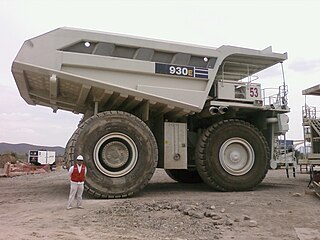
The Komatsu 930E is an off-highway, ultra class, rigid frame, two-axle, diesel/AC electric powertrain haul truck designed and manufactured by Komatsu in Peoria, Illinois, United States. Although the 930E is neither Komatsu's largest nor highest payload capacity haul truck, Komatsu considers the 930E to be the flagship of their haul truck product line.
The Komatsu 830E is an ultra class haul truck used in open pit mining designed and built in Peoria, Illinois by Komatsu America Corporation, whose parent company is the Japanese held company Komatsu Ltd.

The International TranStar, is a range of Class 8 trucks produced by Navistar International for North America. Produced nearly exclusively as a semitractor, the product range is focused towards local delivery and regional shipping.
A specialized set of jargon describe the tools, equipment, and employment sectors used in the trucking industry in the United States. Some terms may be used within other English-speaking countries, or within the freight industry in general. For example, shore power is a term borrowed from shipping terminology, in which electrical power is transferred from shore to ship, instead of the ship relying upon idling its engines. Drawing power from land lines is more efficient than engine idling and eliminates localized air pollution. Another borrowed term is "landing gear", which refers to the legs which support the front end of a semi-trailer when it is not connected to a semi-truck. Some nicknames are obvious wordplay, such as "portable parking lot", in reference to a truck that carries automobiles.
The Bucyrus MT6300AC is an off-highway, ultra class, two-axle, diesel/AC electric powertrain haul truck designed and manufactured by Bucyrus International Inc. in the United States. The MT6300AC is Bucyrus' largest, highest payload capacity haul truck, offering one of the largest haul truck payload capacities in the world, up to 400 short tons (363 t). The closest analogs are Liebherr T 282B, Caterpillar 797F, which can carry the same weight, and BelAZ 75710 with 450 tons payload capacity.
The Komatsu 960E-1 (960E) is an off-highway, ultra-class, rigid-frame, two-axle, diesel/AC electric powertrain haul truck designed and manufactured by Komatsu in Peoria, Illinois, United States. The 960E-1 has been Komatsu's largest, highest capacity haul truck, offering a payload capacity of up to 360 short tons (327 t). The 960-E1 is the first generation of the 960E series of haul trucks and is alternately referred to by Komatsu specifically as the 960E-1 or generally as the 960E.
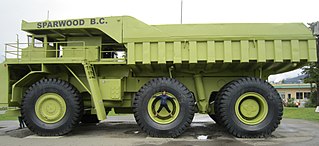
The Terex 33-19 "Titan" was a prototype off-highway, ultra class, rigid frame, three-axle, diesel/AC electric powertrain haul truck designed by the Terex Division of General Motors and assembled at General Motors Diesel Division's London, ON, Canada assembly plant in 1973. Only one 33-19 was ever produced and it was the largest, highest capacity haul truck in the world for 25 years. After 13 years in service, the 33-19 was restored and is now preserved on static display as a tourist attraction in Sparwood, BC, Canada.

Unit Rig was a manufacturer of haul trucks, sold under the brand name Lectra Haul.
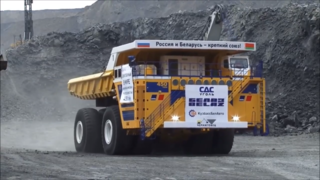
The BelAZ 75710 is an ultra class haul truck manufactured in Belarus by BelAZ. As of 2013, it was the world's largest, highest payload capacity haul truck.
The Payhauler is a series of dump trucks that were produced from 1956 to 2003. Introduced by International Harvester as the International Harvester Payhauler, the line was spun off in 1982 into a separate company, the Payhauler Corporation.
